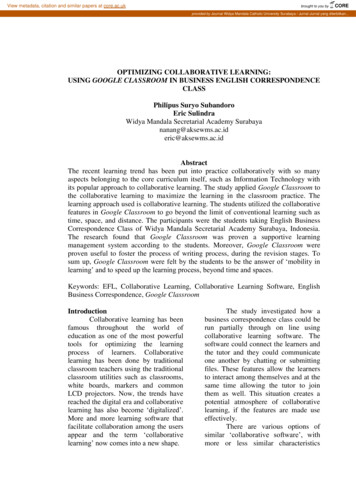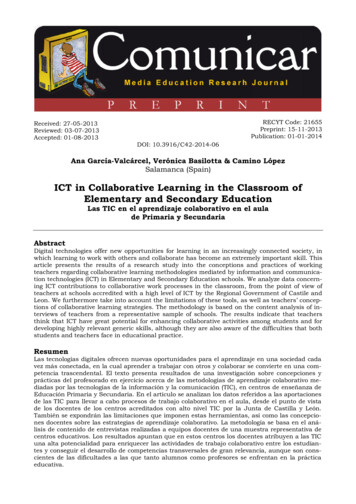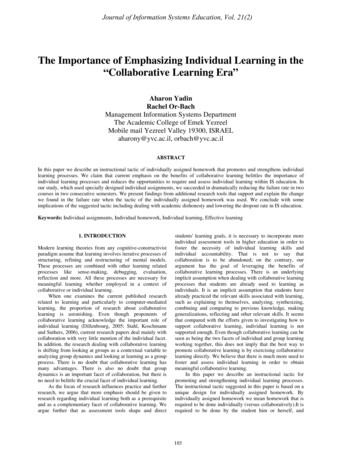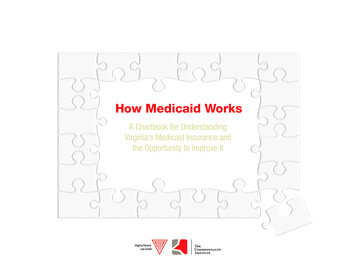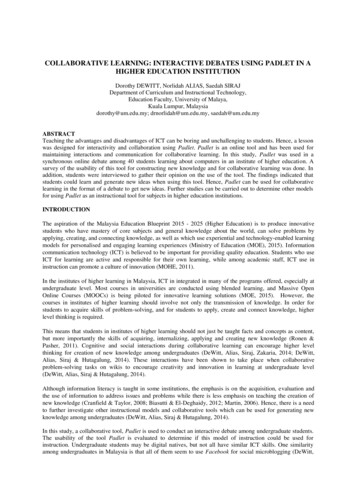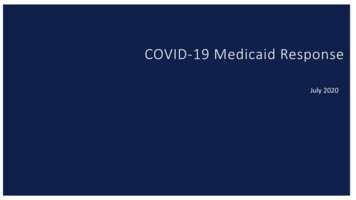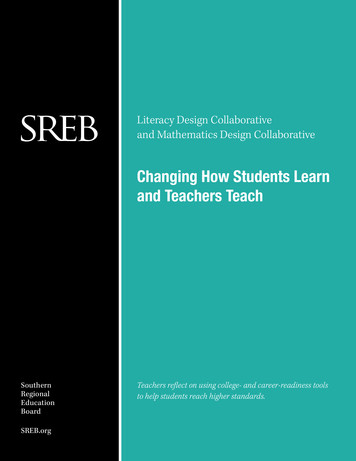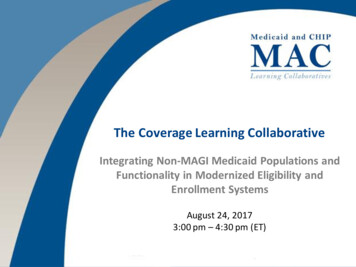
Transcription
The Coverage Learning CollaborativeIntegrating Non-MAGI Medicaid Populations andFunctionality in Modernized Eligibility andEnrollment SystemsAugust 24, 20173:00 pm – 4:30 pm (ET)
AgendaSetting the StagePotential Benefits of IntegrationState Experiences: Lessons Learned and Best PracticesAppendix2
Setting the Stage
Our Goals for Today4Explore the requirements around integrating non-MAGI populations intomodernized eligibility and enrollment systems and benefits that can be achieved.Review states’ experiences integrating non-MAGI populations to identify keyplanning considerations and lessons learned.Highlight lessons learned and best practices states can adopt as they continue orbegin integrating non-MAGI populations into modernized eligibility andenrollment systems.
Approach5State InterviewsIdahoKentuckyNew JerseyOhioVirginiaState selection criteria: States that have completed or made significant progress toward integrating non-MAGIpopulations and functionality into their modernized eligibility and enrollment systems. Interviewed statesincluded a geographic mix of SBM and FFM states, Medicaid expansion and non-expansion states, and stateswith different vendors.Two rounds of interviews focusing on: Planning for integration System design and development strategies Approaches to testing and training Benefits of integrationKey challenges and lessons learnedBest practicesJune 2015 Learning Collaborative“Streamlined eligibility and enrollment for non-MAGI populations”Accessible at: ions.pdf
Who Are Non-MAGI Populations?6Common Eligibility Categories and PopulationsAGED,BLIND &DISABLEDOTHER Individuals eligible for SSI assistance Medically needy individuals Individuals 65 at or below 100% FPL Children receiving foster care, adoptionassistance, or kinship guardianshipassistance under title IV Institutionalized individuals Working disabled Individuals eligible for Medicare SharedSavings Program (including QMB, SLMB,QI) Children eligible under the FamilyOpportunity Act for children withdisabilitiesSource: 42 CFR 435.603 Former foster care children up to age 26 Individuals eligible for home andcommunity-based waiver services Women needing treatment for breastand cervical cancer
Key Differences May Impact System Integration7Different household composition and income counting rules apply (e.g., use ofdisregards, types of countable income)Some applicants may need a disability determination or level of care assessmentMany non-MAGI groups are subject to an asset test and asset verificationPost-eligibility requirements apply to many non-MAGI groups, including treatmentof income, spousal impoverishment provisions, and transfer of asset restrictionsThese distinctions led many states to keep non-MAGI eligibility and enrollment separate whenthey implemented new systems, but states are increasingly leveraging modernized eligibilitysystems and the ongoing availability of enhanced federal match to re-integrate eligibilityprocesses as much as possible.
The Case for IntegrationAs part of state system transition andretirement plans, states shouldidentify existing duplicative systemservices within the state and seek toeliminate duplicative system services ifthe work is cost effective, such aslower total cost of ownership over thelong term.42 CFR 433.112(b)(13)CMS Medicaid IT Supplement Version 1.08Reuse of functionality between MAGIand non-MAGI programs should fosterimproved systems integration with theenrollment and eligibilityenvironment, as well as ease ofeligibility/enrollment dataconsolidation and analysis forimproved Medicaid programmanagement and oversight.State solutions must promote sharing, leverage, and reuse of Medicaid technologiesand systems within and among states
The Case for Integration9Integration enables states to implement and operationalize MAGI simplifications and requirements thatalso apply to non-MAGI populations, and to create new functionalities unique to non-MAGI populationsApplication requirements related tosubmission modes, application types, andlimits on informationEx parte renewals42 CFR 435.916(b)42 CFR 435.907Use of electronic notices42 CFR 435.917, 435.918Verification requirements regarding theuse of electronic data sources andreasonable compatibility42 CFR 435.945(k), 435.948(b),435.949(b), 435.952(b)Timeliness and performance standards fordetermining eligibility42 CFR 435.912(a) and (b), 435.912(c)(3)Asset verificationSocial Security Act §1903(i)(24), §1940Non-MAGI rules engine
States Can Access Enhanced Match to SupportSystem Integration10Integrating non-MAGI populations into modernized systems supports programcompliance and allows states to access 90-10 match90%States are encouraged to access enhanced federalfunding for Medicaid eligibility and enrollmentsystems to support automated systems75%Enhanced funding is available formaintenance and operation of systems thatwere built using enhanced 90/10 fundingFederal FundingFederal FundingDecember 2015 FinalRule made permanentthe enhanced match foreligibility and enrollmentprojects that satisfyseven conditions andstandards10%Non-Federal Funding25%Non-Federal Funding Are modularAdvance the Medicaid Information Technology Architecture principleMeet specified industry standardsPromote sharing, leverage, and reuse of Medicaid system technologieswithin and among states Support business results Meet program reporting standards Ensure seamless coordination and integration with the exchangesand allow interoperability with exchanges, public health agencies,human services programs, and community organizationsSources: 42 CFR ds/efr-seven-conditions-and-standards.pdf
Potential Benefits of Integration
States Can Leverage Functionalities Built into ModernizedSystems12Functionalities required for non-MAGI are made possible by more nimblemodernized systems, increasing efficiencies and streamlining processesApplicationModernizedsystems supportdynamic, onlineapplications fornon-MAGIapplicants (ratherthan a fillable PDFor paperapplication) May streamlineapplicationprocess forstates andapplicantsVerificationModernized verificationplatforms can leverage electronicdata sources prior to requestingpaper documentation from nonMAGI consumers Automated or workerinitiated electronic assetverification is made feasibleusing electronic data sourcesInnovative functionality built intomodernized systems may allownon-MAGI consumers to uploaddocumentation as neededDeterminationAn integratedeligibility hierarchycan determineeligibility across allMAGI and non-MAGIbases ofMedicaid/CHIPeligibility andfacilitatecoordination andtransfer ofinformation betweenMedicaid, CHIP, andthe Marketplace
States Can Leverage Functionalities Built into ModernizedSystemsRenewalsEx parte functionality inmodernized systems can beleveraged for non-MAGI groups Facilitates implementationof streamlined renewalrequirements for non-MAGIpopulations and simplifiesprocesses for states andbeneficiariesCan use modernized system’spre-populated renewal formfunctionality to streamlineprocesses for non-MAGIbeneficiaries when ex parte isnot possibleNoticesA modernized systemcreates a more nimbleplatform for noticegeneration and for updatingor improving notices13
Integration Can Streamline Non-MAGI Eligibility andEnrollment14More Efficient for StatesBetter Consumer Experience Embedded verifications allow workforce towork in a single system, rather than togglebetween systems Modernized and intuitive online applicationimproves overall experience and increaseslikelihood of complete applicationsubmission Automated rules engine increases theaccuracy of eligibility decisions Embedded electronic verifications simplifyapplication process and lead to faster andmore accurate determinations Enhanced ability to conduct ex parterenewals requires fewer consumers toactively complete renewals and promotescontinuity of coverage
State Experiences:Lessons Learned and Best Practices
Key Takeaways from Leader StatesIntegration is a complex task that will take time You will want to move fast, but will need to move slowly, particularly with testingIncremental integration brings less risk Designing, testing, migrating data, and implementing functionalityincrementally decreases the risk of failureOrganizational challenges will influence project timeline andsuccess Agency decision-making structure, IT/policy coordination, resources, and staffinglevels will impact project outcomeIntegration is labor intensive Project will require multiple contractors and multiple layers of staffConsider having dedicated state staff with policy and operations experienceInclude both supervisor and worker-level policy, IT, and vendor representativeson integration team16
Key Takeaways from Leader StatesModernizing non-MAGI eligibilityand enrollment processes willrequire a culture shift Modernized systems change long-standing operations and processesLeadership and staff buy-in is an essential element of successBe prepared to make deliberate, policy-driven system designdecisions Design decisions should be driven by state needs and consumer experience notthe vendor; automate with purpose to support policy and operations goalsYou will have to make tough functionality decisions, possibly delaying—orexcluding—desirable functionalityInvesting time in testing and data migration is critical Testing is critical to ensure that established business processes and systeminteractions can continue post-integrationA modernized system that relies on incomplete/inaccurate data will fail—taketime to clean and migrate data17
Key Pieces of the System Integration Puzzle18What have leader states learned?What are the best practicesstates can adopt going forward?There is noone-size-fits-allapproach
Project Planning and Governance: Key Considerations19Project Scope Will integration incorporate MAGI and non-MAGI only, or will it include otherhuman service programs?Do eligibility workers work across human services programs or Medicaid only?Oversight and Management Who are the decision makers and what criteria drive decision making? Who controls access to vendor contracts?Vision, Culture and Values How can automation be used to improve state operations and beneficiary andworker experiences?IT Capacity and Strategy What is your in-house IT capacity? How much reliance on vendors is anticipated? How do IT and policy shops work together?Project Budget and Timeline What is the timeline for key components of integration? How should the project be structured in light of IT and policy team resources?
Project Planning and Governance: Lessons Learned andBest Practices20Lessons Learned Multi-benefit (non-MAGI and human services) “big bang” integration projects candelay non-MAGI integration and also increase risk Project can suffer if there is not a strong governance structure to supportdecision making Existing IT staff and vendors may be insufficient (in size and skill) to support an integration project Expect delays and changes in directionBest PracticesBuy-in from Secretary and Governor offices is essential to establish a common vision andmotivate workforceUse support from the Executive to identify and break down silos between different agencies and among IT andpolicy staff; particularly important if integrating multiple benefit programsEstablish a governance structure that includes all relevant parties. Incorporate staff and fieldbased feedbackBudget for staffing needs – IT, policy, and vendors (DDI, testing, IV&V, etc.)Bring functionality online incrementally; don’t plan “big bang” rollouts
System Design and Development: Key Considerations21Selecting a Contractor What strengths are you seeking in a contractor?Experience? Rules integration? Intuitive design? Will the contractor have responsibility for design only or ongoingoperation, too?Worker Portal What is the desired worker experience?Consumer-Facing Tools and Functionalities What is the desired consumer experience?Back-End System Interfaces Are the parameters for back-end logic clear? What planning is necessary to ensure interoperability with non-MAGIverification sources and business partners? How will system modifications affect transactions between theeligibility system and MMIS?
System Design and Development: Lessons Learnedand Best Practices22Deliberate system design and incremental implementation mitigates risk whilesupporting consumer-centric functionalityLessons Learned “Out-of-the-box” solutions may not address state needs Over-customization creates delays and increases complexity A change to a single eligibility rule can adversely impact an entire rule set andrelated data, so integrated planning/testing is keyBest PracticesMaximize worker efficiencyAim for intuitive, consumer-centric design, which is particularly important for complex MedicaidcategoriesNon-MAGI consumers must navigate additional application points due to additional non-MAGI requirementsFocus on building an integrated rules engine to ensure accurate and timely determinationsMake eligibility rule components small and discrete so that a single rule change does not impactan entire rule set
Project Planning and System Design: State Examples 23Established centralized senior leadership group for planning and implementation, anda program management office to ensure cross-department collaborationo Also engaged business partners that interact with the eligibility andenrollment system (e.g., MMIS)Determinations for LTSS, ABD, and Qualified Disabled Working Individuals moved from manual to automatedMedical disability determinations moved from paper-based process to a worker-initiated electronic processAn Asset Verification Solution (AVS) automation process was introducedModernized system creates single household cases; SSI and MAGI enrollees within the same household werepreviously in separate caseso Workers are now required to know eligibility requirements for both groupsBuilding platform modularly; each piece is tested with counties prior to launchIT and policy staff coordinate closely on each piece of functionality to confirm the policy beforethe IT buildo State created and tested new non-MAGI application in paper form prior to system buildFocusing on engineering the system for ease of governance; ensure integration between SNAP,TANF and Medicaid is done such that each agency can proceed on its required schedule and meet itsregulatory requirements (e.g., provide for separate required notifications where CMCS and FNS notificationsare not harmonized; provide separate data structures where shareable elements are shared)
Best Practices for Project Planning and System Design:Idaho24 Initiated project with “cultural conversations” between leadership and staff to share vision Framed system integration through a business and cultural perspective and focused onconsumer experienceo Applications are “conversations” between the consumer and the eligibility workero Goal: Connect consumers to services, not programso De-silo benefit programs from consumer perspective All benefit programs use a single source of applicant data to ensure all programs have access to themost accurate and up-to-date information Eligibility rule components are smalland discrete Applicant web portal is a one-stopshop with a user-friendly designOnline integrated portal:www.livebetteridaho.org
Testing: Key Considerations and Lessons Learned25Key Consideration: Testing Timeline Does testing plan accommodate ongoing and adequate testing duringsystem build, data migration, and ahead of launch? Is testing schedule reactive to project delays? Are testing resources sufficient?Key Consideration: Testing Partners How to include business partners in testing?Lessons Learned More extensive testing would have surfaced key issues (e.g., erroneous data inlegacy system) and prevented problems at rollout Testing protocol failed to identify issues because it lacked field-based testingand had an insufficient mix of eligibility scenarios Retesting only discrete resolved issues—instead of retesting the whole case—obscured otherissues; a change to fix one part of the system can impact a different part of the system Identify defects you can “live with” because some may not be resolved prior to launch; have clearrules for assessing the severity of defects
Testing: Best Practices26Thorough, comprehensive testing is key – “fail small and fail often”Do end-to-end system testing with real data and cases after datamigrationAlso test individual system components independentlyInclude all business partners in testing (i.e., MMIS) becauseeligibility and enrollment systems touch many interfacesREMINDER: Bring functionality online incrementally; don’t plan“big bang” rolloutsPilot functionalities either regionally (by county) or by subset of thenon-MAGI population“Avoid the 6 o’clock news.”
Data Migration: Key Considerations and Lessons Learned27Key Consideration: Approach Will data be migrated incrementally or all at once?Key Consideration: Data Quality What is the quality of data in legacy system? What strategies will the State employ to ensure correct data is migrated?Key Consideration: Schedule and Timing What factors may influence the timing and schedule for data migration? How might staff and contractor resources be used to assist withmigration?Lessons Learned Data cross-walk between old and new systems is time-consuming but essential, and oftenrequires human—not only computer—touches Failure to clean data prior to migration expended resources on migrating bad data,duplicate data, or data that should not have been migrated Data that is migrated incrementally by eligibility group split households with multiple eligibility groupsand cases had to be manually re-merged Prevent newer data in modernized system from being overwritten by legacy system data during phasedmigration
Data Migration: Best Practices28Poor data quality can derail a system launch, but careful planning for data migrationensures data integrityMigrate data incrementally to allow for a testing and resolutioncycleConsider and plan around times of high E&E system volume (renewals,Marketplace open enrollment)Don’t let arbitrary deadlines rush migration.Rigorously test data integrity prior to migration to minimize errorsduring migration and data cleanup in modernized systemFor integrated Medicaidand human servicessystems: Don’t assign datato specific programs – usethe same income data forMedicaid, SNAP, TANF, etc.and then apply programspecific rulesClean the data, test migration, clean the data again, and test migration again;repeat as neededCarefully map legacy data fields to modernized system to preventorphan dataMake data components small and discrete; this also helps when looking towardhuman services integration
Data Migration: State Examples Certain coverage categories were coded into modernized system using a “fake”code to avoid premature redeterminations after migration Multi-beneficiary households were split during migration; workers manually remerged these cases post migration to facilitate unified eligibility determinationsand combined notices for a household Legacy system is now owned by SNAP/TANF and is used by Medicaid forhistorical reference Migrated data in small increments with high level of “human judgment” toconfirm data cross-walk Used technology to load data at a high volume while workers later cleaned andmerged cases as needed Kept data elements small and discrete so that rules engine could use same datafor different human services programs29
Best Data Migration Practices: Virginia30 Non-MAGI cases were converted/migrated in two waves: cases that did not havean overdue renewal, and cases that failed the first conversion attempt Cases were cleaned up in the legacy system manually by workers prior to conversiono Workers were encouraged to compare case names in VaCMS and MMIS; combine paper files; checkAid Categories; and verify that case and mailing addresses matched in both systems Special attention was paid to cases overdue for renewal; workers were required to complete therenewals prior to conversion After conversion, a shell case was created due to all data not being available in the legacy systemo Encouraged workers to work shell cases and enter data on-screen within set timeframeso Users were allowed to wait until next renewal or change before touching the caseo A shorter turnaround time would have ensured cases were in the proper ongoing status and able tohandle automatic updates that may occur on annual timeline Special conversion/migration notes: performed mock conversion; spend down cases had to be convertedmanually; a special file was needed to add patient pay amount during conversion; extend Medicaid caseswere difficult as interim reviews were important; workers had to determine the correct Aid Categories Non-MAGI cases migrated incrementally ahead of other human services programs (modernized systemincludes Medicaid, SNAP, TANF, and Child Care) New system enables MAGI and non-MAGI members of household to be included in same case file tosimplify handling of case files
Workforce Training: Key ConsiderationsTraining Timeline When will training occur relative to rollout? Will training be multi-phased? Virtual and/or in-person?Training Content How will training on policy, operations, and IT be integrated? Workforce structure influences training planAre workers county-based or state-based?Do they handle Medicaid only or other human servicesprograms?Will some staff need more intense training on particularnon-MAGI populations?Will they have to use multiple systems until Medicaid andhuman services are fully integrated?31
Workforce Training: Lessons Learned and Best Practices32Preparing agencies is as important as preparing the system;workforce structure will influence training strategyLessons Learned Retraining is needed if system launch delays create a gapbetween training and launch Separating IT training from policy training was “ineffective” Plan sufficient time for training Train early, but also make sure that training (and trainers) reflect last-minutechanges to functionalityBest PracticesIntegrate policy, operations, and IT/systems training content so workers have a full view of theprocess – can answer all “why” questionsIn addition, train policy and IT staff togetherProvide multiple training opportunities and formats, including ongoing re-trainings, so workerscan apply training in real-time Post training modules and webinars online for workers to access as neededMinimize time between training and system launchEnsure vendor trainers are fully trained on functionality unique to your state
Workforce Training: State Examples 33Leadership sets the stage for training – explains the reason for the training and responds to questions(a “cultural conversation”)Training was incremental and on-demand to avoid disrupting regular workBuilt 10-15 minute learning blocks and a series of webinars to “connect the blocks”o Webinars walk through the progression of what workers see on their screensTraining is supplemented with process documentsFinal training stages rely on a statewide videoconferencing system State trained workforce on-site both before and during system rolloutAlso established a centralized team called “Operation Field to Frankfort”o Was staffed with eligibility workers, IT staff, and vendor staffo Also served as a training center where eligibility workers functioned alongsidevendor and IT staff to troubleshoot difficult cases while becoming more comfortable with system functionalityo Was the predecessor to a now-permanent 50-person troubleshooting and training state team that focuses onbacklogs, difficult cases, and other pressing needs Workers are trained on each system enhancement as they are released, eitherthrough webinars or in-person if the enhancement is complicatedWorker portal training conducted on-site over 6-8 monthsCounty-level supervisors are trained to become trainers for their county at a central locationo Supervisors are familiar with enhancements prior to training because of the worker feedbackloop used during system buildAll past trainings are available to workers online NewJersey
Discussion34
THANK YOU!Let us know if you have any updates to your contact information orwould like more information on Coverage LC meetings.Archived products and tools produced by the Collaborative are available online ningcollaboratives/coverage/index.htmlContact: MACLC@mathematica-mpr.com
Appendix
Contact Information for Leader States37Several states that have completed or made significant progress toward integrating non-MAGI populations into their modernizedeligibility and enrollment systems are available to offer guidance and answer your questions about topics covered in this presentation,including: project planning and governance; system design; IT/systems development; data migration; testing; and workforce training.Agency: Idaho Department of Health and WelfareContacts: Greg Kunz, Deputy Administrator, Division of Welfare/Self Reliance Programs, Greg.Kunz@dhw.idaho.gov,(208) 863-2044; Shannon Brady, Deputy Administrator, Division of Welfare/Self Reliance Programs,Shannon.Brady@dhw.idaho.gov, (208) 334-4954Topic Areas: Project planning and governance; system design; IT/systemsdevelopment; workforce trainingAgency: New Jersey Department of Human ServicesContact: Meghan Davey, Director, Division of Medical Assistance and Health Services,Meghan.M.Davey@dhs.state.nj.usTopic Areas: System design; IT/systems development; testing; workforce trainingAgency: Ohio Department of MedicaidContact: Jenni Langlois, Ohio Benefits M&O, Jennifer.Langlois@medicaid.ohio.gov, (614) 752-3591Topic Areas: Data migration; testingAgency: Kentucky Cabinet for Health and Family ServicesContact: Jennifer Harp, Deputy Executive Director, Office of Administrative and Technology Services,Jennifer.harp@ky.gov; LeAnne Mullins, Director, Division Eligibility Systems, Office of Administrative and TechnologyServices, LeAnne.Mullins@ky.gov, 502-564-0105 ext. 2847Topic Areas: Project planning and governance; system design; IT/systems development; data migration (Mullins);testing (Mullins); workforce training (Harp)
Other Tools and ResourcesDecember 2015 final rule extending enhanced 90-10 match te Medicaid Director Letters regarding 90-10 rule implementation ownloads/SMD16004.pdf ownloads/smd16009.pdf ownloads/smd16010.pdfOMB A-87 waiver to allow use of 90-10 Medicaid match for human service integration ownloads/SMD072015.pdf ownloads/SMD-01-23-12.pdf38
data sources prior to requesting paper documentation from non-MAGI consumers Automated or worker-initiated electronic asset verification is made feasible using electronic data sources Innovative functionality built into modernized systems may allow non-MAGI consumers to upload documentation as needed . Determination . An integrated



